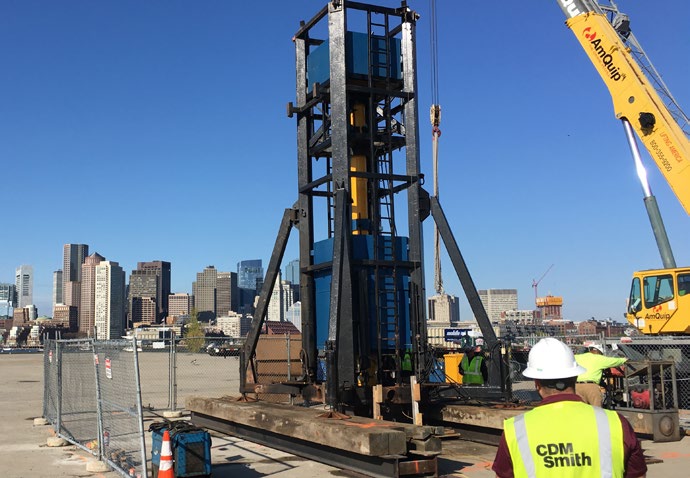Boston Waterfront Redevelopment: Re-use of Existing Pier Piles
Massachusetts Port Authority
East Boston, Massachusetts

Scope of Foundation Work
Technology used, reason for the reuse:
The existing concrete pier was constructed in 1955 and founded on 14-inch-diameter, concrete-filled, steel pipe pile foundations. The piles exhibited severe corrosion of the steel above the mudline necessitating a two-phase pile load testing program to evaluate whether the piles could successfully be re-used. The existing piles, in combination with new drilled shaft foundations, were designed to support four 5- to 7-story apartment buildings made the project financially feasible.
Methodology to determine existing capacity:
A two-phase pile load testing program was developed to establish if the piles could support design loads of 240 kips for project financial feasibility and 300 kips for reduction in foundation costs. The Phase 1 program consisted of rapid load and dynamic load testing on two piles with two loading intervals. Based upon the favorable Phase 1 results, the Phase 2 program involved rapid load testing on two piles and dynamic load testing on ten piles with three loading intervals. The Phase 2 program confirmed the favorable results and applied across varying strata thicknesses and pile embedment depths.
Retrofit construction activities conducted:
The structural engineer developed a steel sleeve repair plan to allow the piles to transfer up to 300 kips to the foundation bearing strata. The structural repair consisted of grouting an 18-inch-diameter, 0.5-inchthick steel pipe (sleeve) over the existing piles and grouting the annulus. The repair was conducted above the mudline where the most severe corrosion was observed during the previous structural evaluation.
Conclusions
Cost savings:
The cost-effective dynamic and rapid pile load testing program saved upfront costs by avoiding the need to repair reaction piles for static pile load testing. By conducting a two-phase load testing program, higher pile capacities were achieved without damaging any existing piles and permitted the structural engineer to achieve the maximum number of floors for the structures during final design. The pile load testing program cost of approximately $1 million and confirmed the project was financially feasible for the developer and owner.
Cost saving statistics:
- 1. Pile load testing program cost approximately $1 million.
- 2. Confirmed the project was financially feasible.
- 3. Reduced project carbon footprint.



